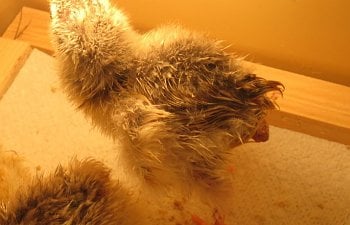Omphalitis
Also known as
Mushy Chick Disease
&
Yolk Sack infection
Omphalitis is a common cause of death in chicks during the first week of life and most common with artificially hatched chicks. It is a bacterial infection of the yolk sac. Various bacteria may be involved in yolk sack infection,
E.coli, Staphylococci, Proteus, Clostridia, fecalis and Pseudomonas.

Understanding the yolk sack
Growth of a chick begins in the small fertilized area at the top of the yolk. A network of blood vessels begins to develop spreading from the embryo out over the yolk. The yolk sac is attached to the chick's navel and the chick draws nourishment from it, producing an enzyme that changes the yolk material so that it can be used as a food by the developing embryo. As the chick hatches any remaining unused yolk is drawn into the chick’s abdomen or “navel”. It will supply nourishment for the chicks first few days after hatching.

CAUSES
~ Egg & Embryo ~
Omphalitis may be caused by a bacterium that enters through the porous egg shell. Unfortunately, incubation conditions are ideal for breeding bacteria as well as incubating eggs. BEWARE the egg that explodes in the hatching tray! This easily contaminates other eggs.
~ Chick ~
As the chick is hatching its exposed umbilicus (navel) can easily be infected by bacteria. More susceptible are those newly hatched chicks resting on dirty eggs, un-sanitized incubators, and also with assisted hatching. A chick removed from the incubator prior to complete healing of the navel is also giving a chance of infection in the brooder.


Symptoms
The chicks become lethargic and die quickly either during incubation or after hatching, with most dying within 48 hours from the infection. Symptoms may VARY depending on bacteria and can include poorly healed, open navels or enlarged navels, subcutaneous edema (large fluid volume in the abdomen), bluish color of the abdominal muscles and often unabsorbed yolk materials that could even smell putrid. Often yolks are ruptured and peritonitis (inflammation of the inner wall of the abdomen) is common. Chicks have little interest in food and water and are attracted to heat. Mortality often begins at hatching and can continue for 10/14 more days.


subcutaneous edema (large fluid volume in the abdomen)


unhealed navel after yolk sack rupture below


Below is an unhealed OPEN Navel

Below is an unhealed OPEN Navel

Below is an image of a duckling's belly with an infected navel.
It hatched with an unabsorbed yolk, and was about a week old in the pic.
The duckling DID survive, and is a loudmouth little call duck juvenile.


Treatments
There is no specific treatment for omphalitis. Most affected birds die.
Prevention is the best method.
A few suggestions for treatment are to clean the navel area with iodine several times a day. I have also used Veterycin gel spray. Freshen up water with multi vitamins or Save-A-Chick daily. Watch brooder temperatures as Chilling & overheating may increase losses at this stage. Isolate chick from others to prevent spread of bacteria and avoid pecking injuries.
Keep the brooder as clean and fresh as possible. Keep in mind that it may be wiser to humanely destroy the more severely affected chicks.

Prevention
The disease is prevented by careful control of temperature, humidity, and sanitation in the incubator and Hen House! Keep the Coop and nesting boxes clean and dry. Set only fresh, clean, non-porous and uncracked eggs. If it is necessary to set dirty eggs, they should be kept away from clean eggs. Gentle sanitizers are available for cleaning dirty eggs. Always wash hands, especially when turning! ALWAYS disinfect incubators and equipment before AND after use!

A BIG Thank you to all of the image contributors for this Article.
Also known as
Mushy Chick Disease
&
Yolk Sack infection
Omphalitis is a common cause of death in chicks during the first week of life and most common with artificially hatched chicks. It is a bacterial infection of the yolk sac. Various bacteria may be involved in yolk sack infection,
E.coli, Staphylococci, Proteus, Clostridia, fecalis and Pseudomonas.
Understanding the yolk sack
Growth of a chick begins in the small fertilized area at the top of the yolk. A network of blood vessels begins to develop spreading from the embryo out over the yolk. The yolk sac is attached to the chick's navel and the chick draws nourishment from it, producing an enzyme that changes the yolk material so that it can be used as a food by the developing embryo. As the chick hatches any remaining unused yolk is drawn into the chick’s abdomen or “navel”. It will supply nourishment for the chicks first few days after hatching.
CAUSES
~ Egg & Embryo ~
Omphalitis may be caused by a bacterium that enters through the porous egg shell. Unfortunately, incubation conditions are ideal for breeding bacteria as well as incubating eggs. BEWARE the egg that explodes in the hatching tray! This easily contaminates other eggs.
~ Chick ~
As the chick is hatching its exposed umbilicus (navel) can easily be infected by bacteria. More susceptible are those newly hatched chicks resting on dirty eggs, un-sanitized incubators, and also with assisted hatching. A chick removed from the incubator prior to complete healing of the navel is also giving a chance of infection in the brooder.
Symptoms
The chicks become lethargic and die quickly either during incubation or after hatching, with most dying within 48 hours from the infection. Symptoms may VARY depending on bacteria and can include poorly healed, open navels or enlarged navels, subcutaneous edema (large fluid volume in the abdomen), bluish color of the abdominal muscles and often unabsorbed yolk materials that could even smell putrid. Often yolks are ruptured and peritonitis (inflammation of the inner wall of the abdomen) is common. Chicks have little interest in food and water and are attracted to heat. Mortality often begins at hatching and can continue for 10/14 more days.
subcutaneous edema (large fluid volume in the abdomen)
unhealed navel after yolk sack rupture below
Below is an unhealed OPEN Navel
Below is an unhealed OPEN Navel
Below is an image of a duckling's belly with an infected navel.
It hatched with an unabsorbed yolk, and was about a week old in the pic.
The duckling DID survive, and is a loudmouth little call duck juvenile.
Treatments
There is no specific treatment for omphalitis. Most affected birds die.
Prevention is the best method.
A few suggestions for treatment are to clean the navel area with iodine several times a day. I have also used Veterycin gel spray. Freshen up water with multi vitamins or Save-A-Chick daily. Watch brooder temperatures as Chilling & overheating may increase losses at this stage. Isolate chick from others to prevent spread of bacteria and avoid pecking injuries.
Keep the brooder as clean and fresh as possible. Keep in mind that it may be wiser to humanely destroy the more severely affected chicks.
Prevention
The disease is prevented by careful control of temperature, humidity, and sanitation in the incubator and Hen House! Keep the Coop and nesting boxes clean and dry. Set only fresh, clean, non-porous and uncracked eggs. If it is necessary to set dirty eggs, they should be kept away from clean eggs. Gentle sanitizers are available for cleaning dirty eggs. Always wash hands, especially when turning! ALWAYS disinfect incubators and equipment before AND after use!
A BIG Thank you to all of the image contributors for this Article.
Disclaimer: Please note this information is offered as friendly advice only and, whilst I have made every effort to ensure it is accurate, I can not be held responsible if it proves not to be useful in your case!
Educational Incubation & Hatching, w/ Sally Sunshine Click HERE & NOTES section click HERE
Hatching 101 Article click HERE & Assisted Hatching Guide Click HERE
Cabinet Coolerbator ~ Coolerbators ~ Pallet Coops ~ Saloon Coop ~ Pallet Duck House & Duck Care
Processing Support Group~ PINTEREST ALL POULTRY ~Our Serama House of Littles Click HERE ~Mushy Chick Disease ~ Nasty Chicken Butt ~ Easy no Strain Fermented Feed ~ Easy 5gal Waterer ~DIY Light Box for pics Click HERE


